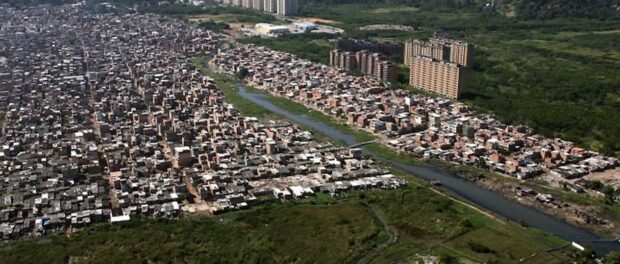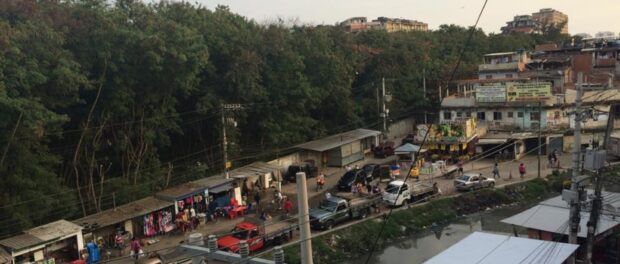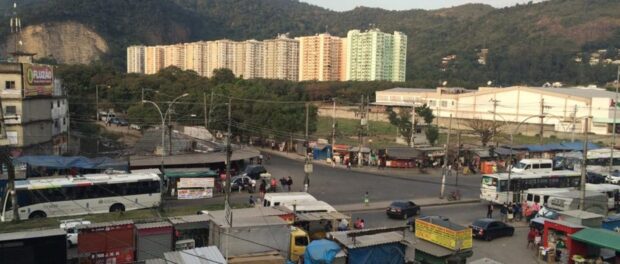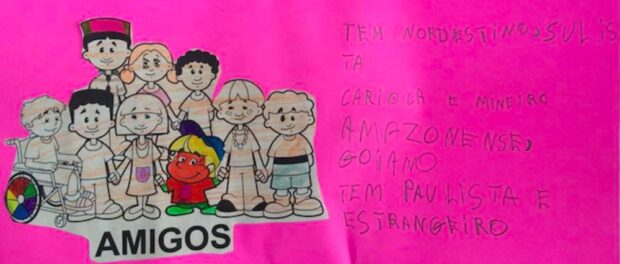
Estação Azul, a lively 24 hour diner, is a hub of commotion in the heart of a large favela called Rio das Pedras. Not formally mapped online, the expansive community sits in Rio de Janeiro’s West Zone between the neighborhoods of Itanhangá, Jacarepaguá, and Anil. Rio das Pedras’ borders are defined by the Tijuca National Park, the Tijuca Lagoon, and private land designated for the expansion of Barra da Tijuca. But despite the prevalence of “Tijuca” in defining its space and in its history, Rio das Pedras has created its own distinct identity.
While the development of Rio’s favelas cannot be traced to one specific common thread, many grew as a result of particular construction projects, urbanization, job cycles or the expansion of an area: Vila Autódromo evolved to meet housing needs among those constructing a new race track, while Favela do Metrô served workers building the metro station at Maracanã stadium. Rio das Pedras is no exception, growing in tandem with Barra da Tijuca in the 1970s and 1980s as the suburb’s demand for labor increased.
Rio das Pedras was named after the river that begins in the Tijuca Forest and runs directly through the favela. Less than 30 years ago, the river was clean enough for children to play, people to bathe and others to wash their clothes in it. Today, the favela faces the same sanitation battle as many of Rio’s other communities; its river resembles an open sewage canal and is lined with concrete until it meets the Tijuca Lagoon.
With over 55,000 residents located on an expanding 90 hectares of land, Rio das Pedras can be divided into two main areas: a more consolidated northern area and a southern area with less developed infrastructure. But to residents, the main divisions within Rio das Pedras are the sub-communities of Areal 1, Areal 2, Areinha, Casinhas, Pinheiro, and Pantanal. The main roads are Rua Nova, Rua Velha, and Engenheiro.
Rio das Pedras was the site of one of the first militias–vigilante off-duty ‘cop gangs’–in the state and, accordingly, still has an absence of drug trafficking gangs. Having observed traffickers gain control in other favelas, residents of Rio das Pedras were already aware and wary of what trafficking could do to a community as the favela developed throughout the 1980s. The original goal of militias in Rio was thus to curb drug trafficking in the favelas in the absence of adequate formal security measures. In the case of Rio das Pedras, homeowners are required to pay a “security fee” to the militia, which has kept drug trafficking at bay. But as militias expanded they also became associated with severe restrictions on residents’ individual liberties, fostering corruption, and their own particularly pernicious breed of violence.
Historically attracting workers from northeastern Brazil, today many of Rio das Pedras’ inhabitants are migrants who, prior to arriving, knew a relative or a friend living there who highly recommended it. The area’s status as a migrant community continues, with more people from northeastern Brazil arriving via the three-day Itapemirim bus that travels directly from the state of Ceará to Rio das Pedras. The original migrant generation was responsible for weaving the area’s local culture, which defines their community today.
Northeastern culture in Rio das Pedras is palpable when visiting the small businesses lining the favela’s streets. Popular local haunts include Granjas (where you can choose your chicken while it’s still alive), Casas do Norte (a store with only northeastern products), and street vendors selling tapioca pancakes (a northeastern food that has been widely adopted by Cariocas).
The local economy within Rio das Pedras thrives, acting as a central hub for smaller favelas like Muzema throughout the region and even beyond. With many residents owning businesses, working in local shops, and spending money in the favela, money is kept circulating within the community in a virtuous cycle of development. In this way, some residents say that although Brazil is in an economic crisis, the crisis has not hit Rio das Pedras as hard as other places.



